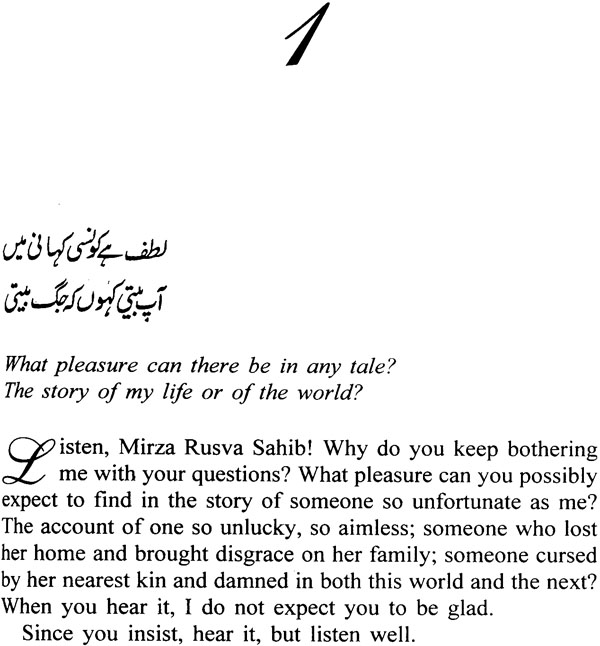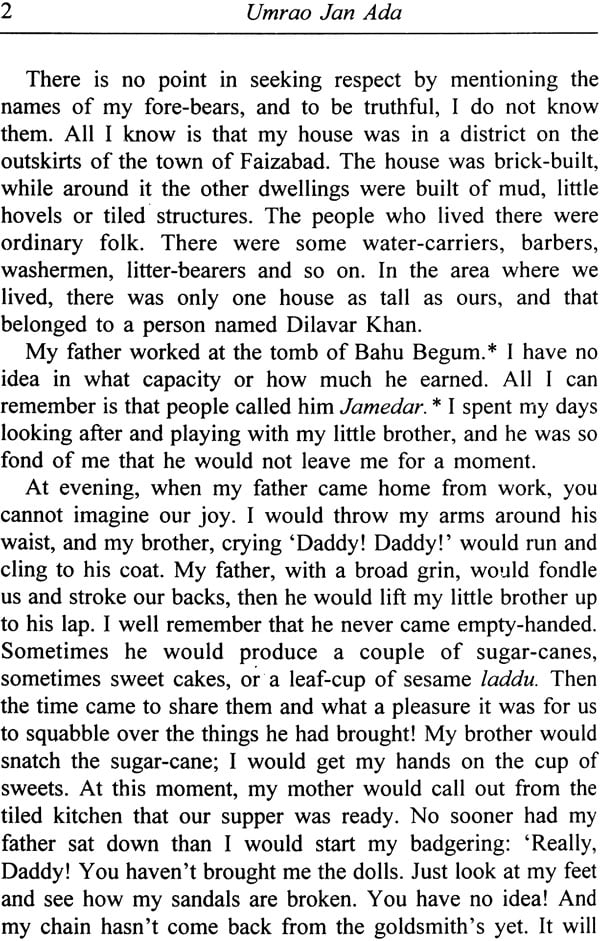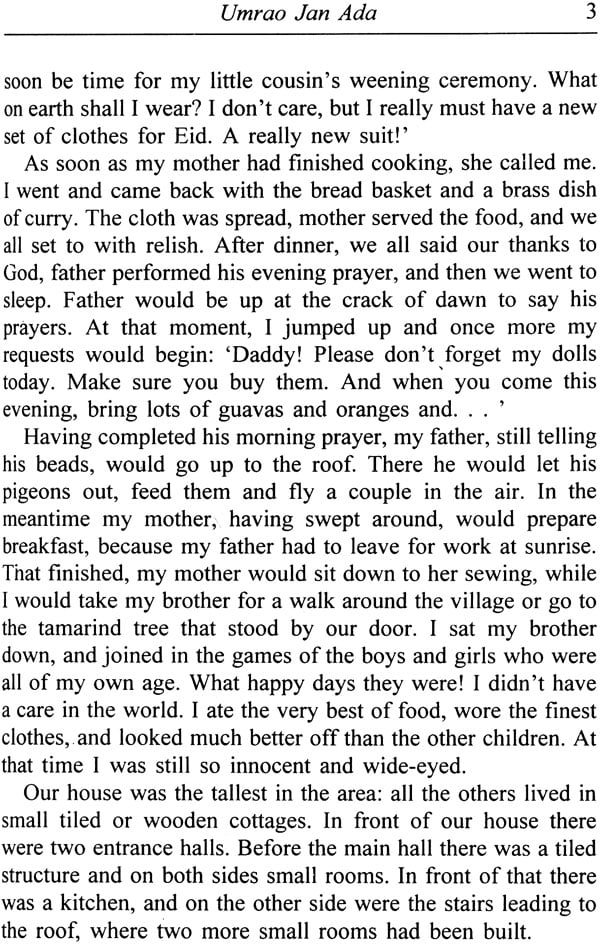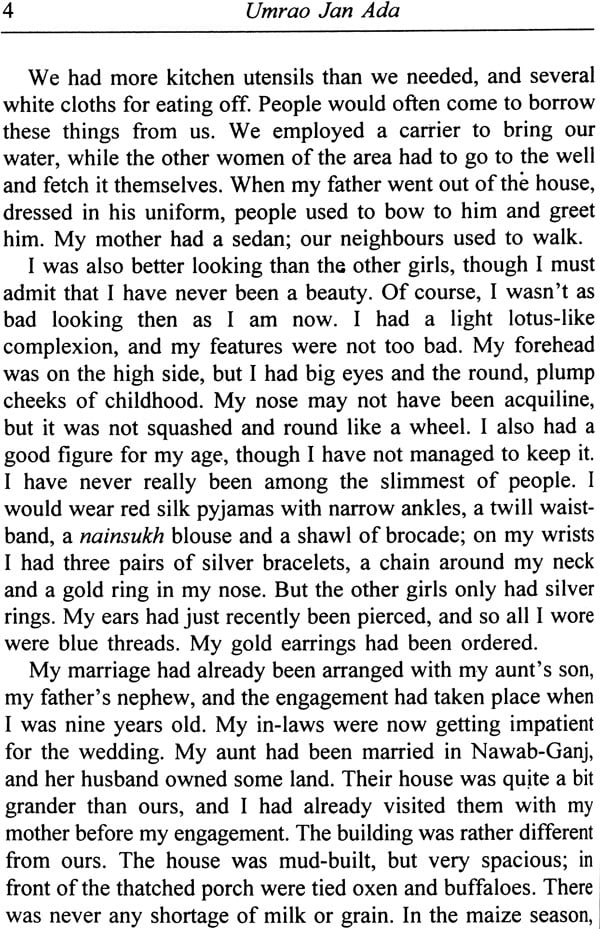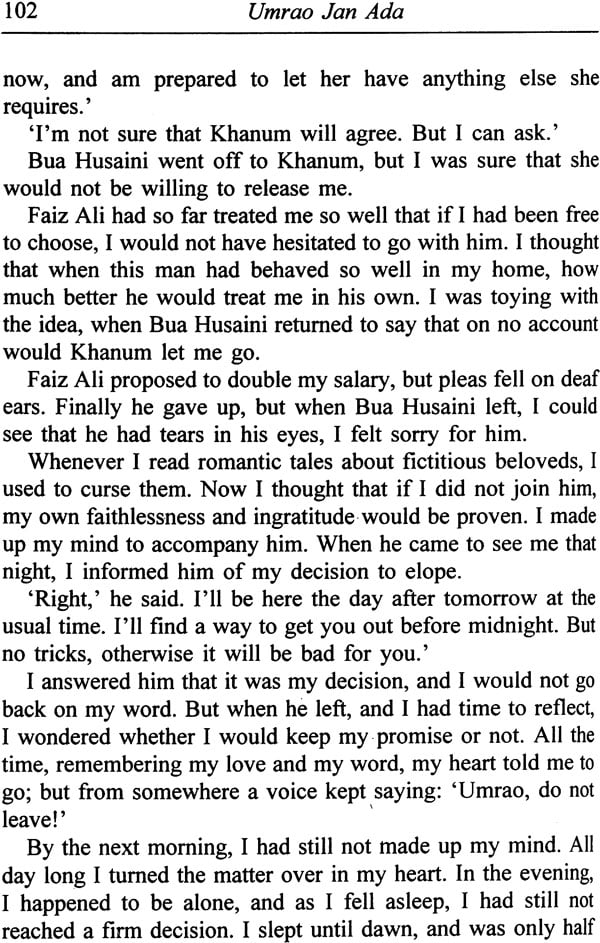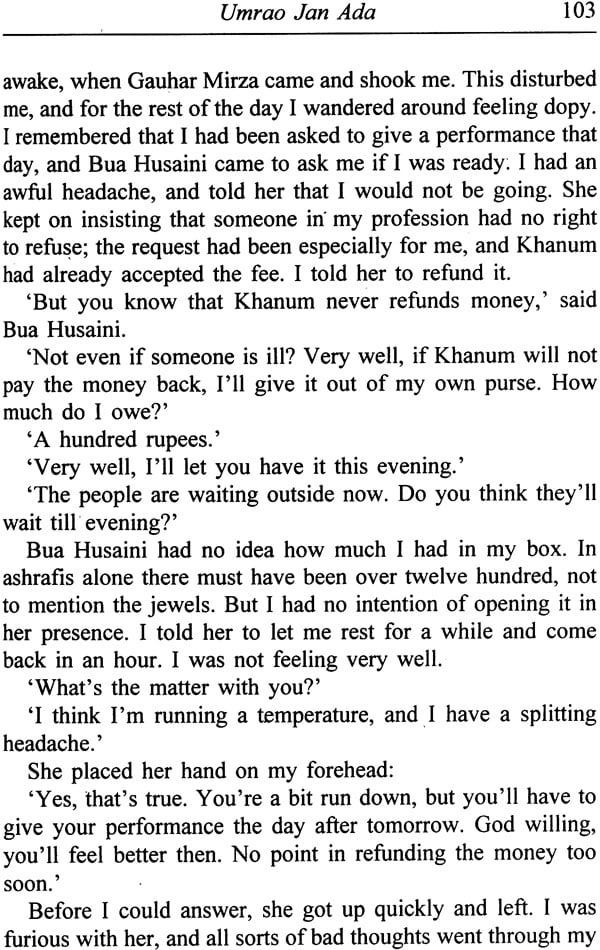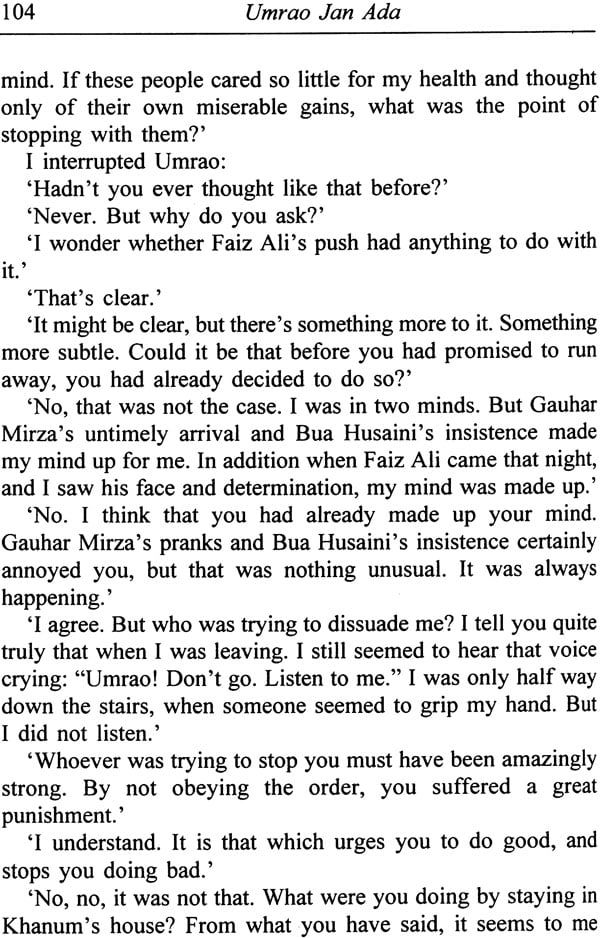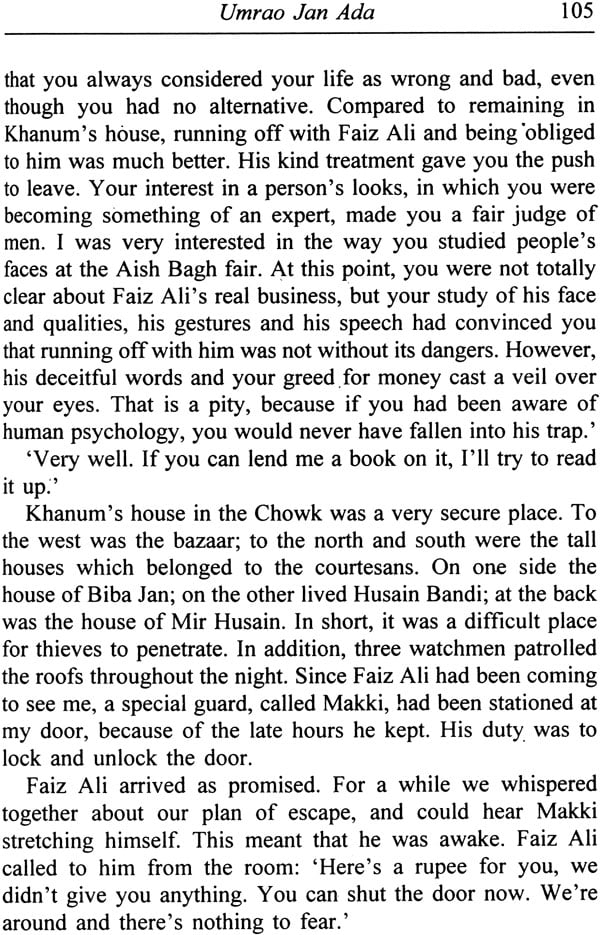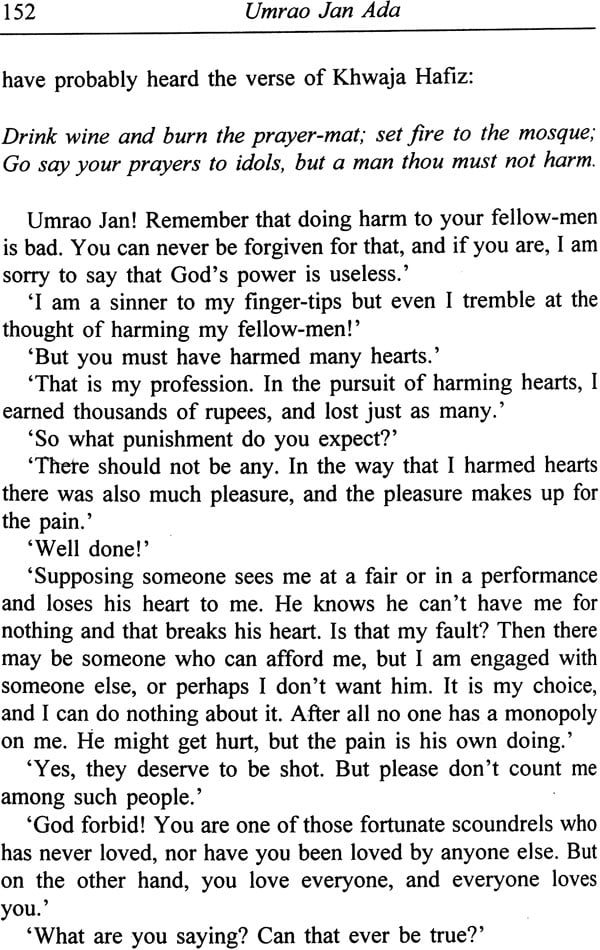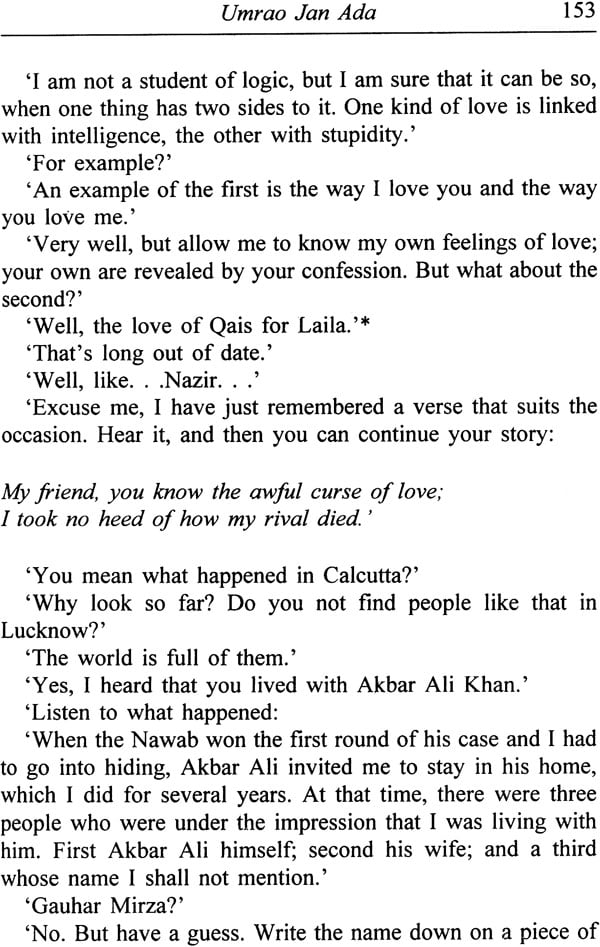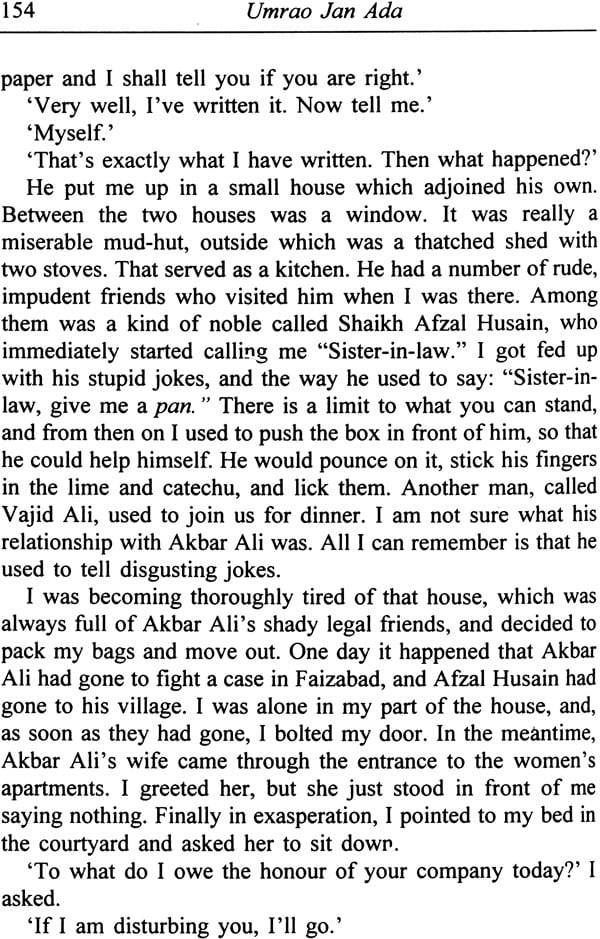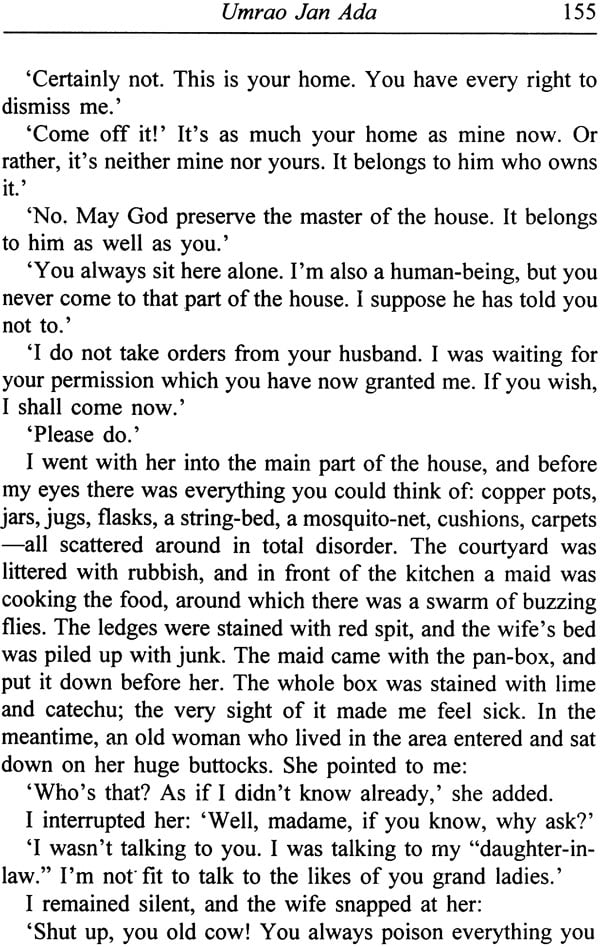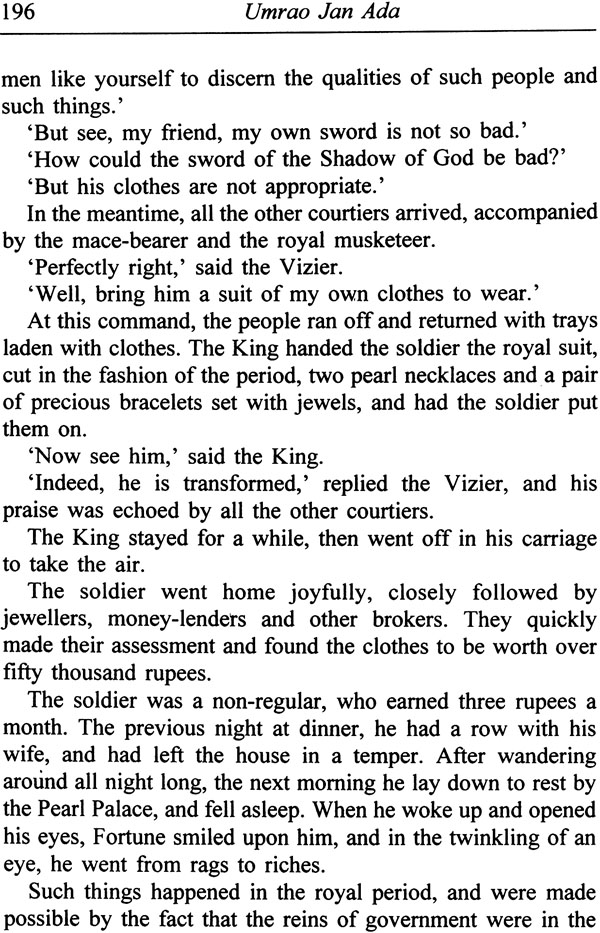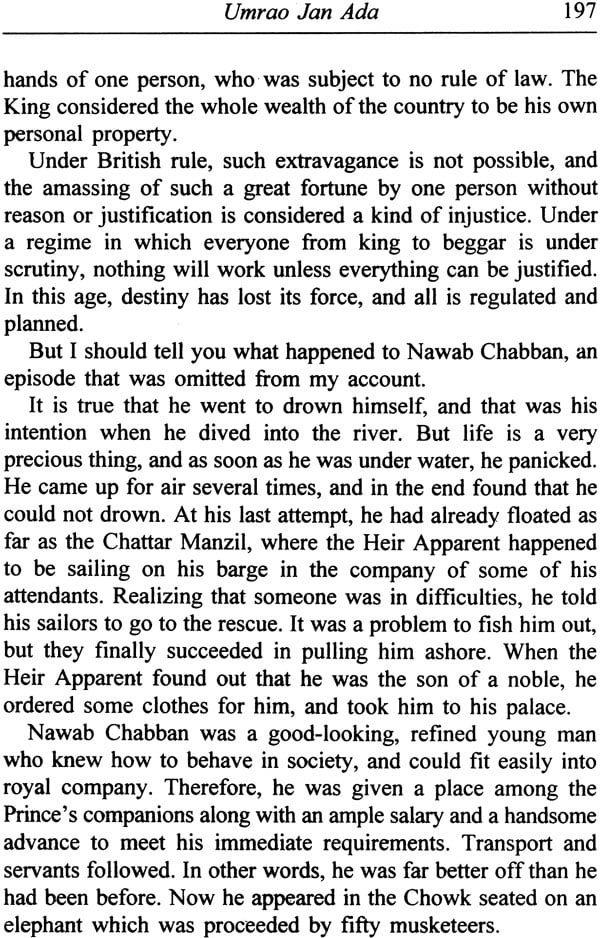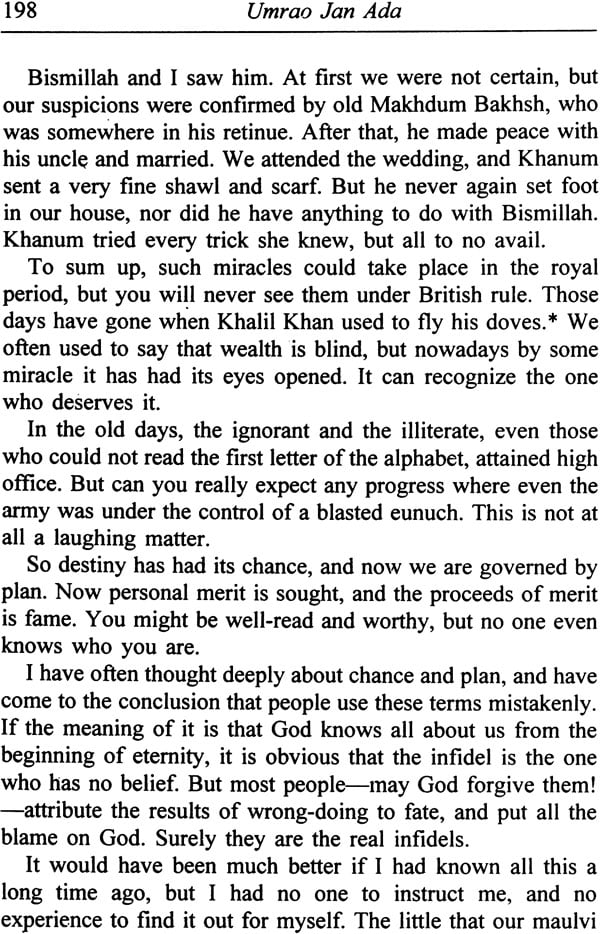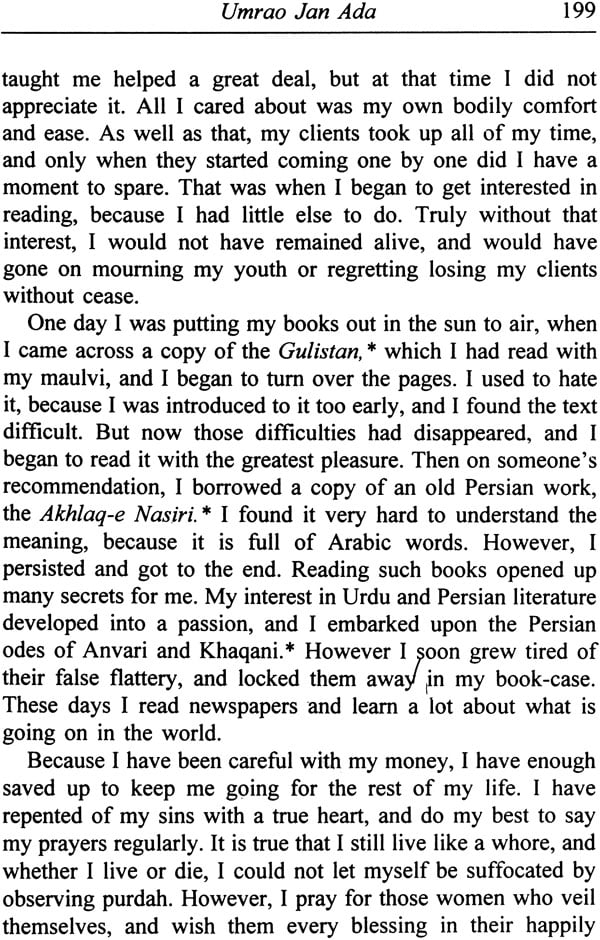
Umrao Jan Ada (Ruswa)
Book Specification
| Item Code: | NAF801 |
| Author: | Mirza Muhammad Hadi Rusva and David Matthews |
| Publisher: | Rupa Publication Pvt. Ltd. |
| Language: | English |
| Edition: | 2007 |
| ISBN: | 9788171673117 |
| Pages: | 245 |
| Cover: | Paperback |
| Other Details | 8.0 inch x 5.0 inch |
| Weight | 120 gm |
Book Description
Umrao Jan Ada, published more than a hundred years ago, was the first true novel in Urdu. It tells the story of a Lucknawi courtesan, a woman of great charm with a reputation as a brilliant poet and singer. Documented by a close friend and supposedly dictated by Umrao Jan, the novel weaves the courtesan’s story with interspersions of poetry, exploration of social dynamics, and the author’s radical subtext with regard to patriarchal double standards.
Umrao Jan Ada is perhaps one of the most enigmatic figures in south Asian literature. To date, the question of her existence, her scholarly abilities and her poetic gifts remain a mystery. While the novel offers no twists and of what it meant to be a courtesan in nineteenth-century India.
Mirza Muhammad Hadi Rusva (1857-1931) was born in Lucknow in the very year which saw to collapse of the Kingdom of Avadh. There is nothing remarkable about his career which book him from teaching in schools to the Nizam’s advisory board on language matters. Like many of his contemporaries, he composed Urdu poetry, and seems to have acquired a reasonable reputation in the art. He wrote a number of novels, but now his fame rests solely on Umrao Jan Ada. Throughout the pages of his book the life and customs of nineteenth century Lucknow, the home of the Navabs are vividly portrayed with great affection and a nostalgia for a glorious past which is no more.
David Matthews is Senior Lecturer in Urdu and Nepali at the School of Oriental and African Studies, London University. His published works include A Course in Nepali, studies on Iqbal, Hali and Anis, as well as An Anthology of Urdu Love Lyrics and A History of Urdu Literature. Among his translations from Urdu are hayat-e- Javed, The Battle of Karbala, Shaukat Siddiqi’s God’s Own Land (Khuda Ki Basti) and a selection of Urdu poems in English verse with an accompanying Devanagari text. At present, he is working on the Persian verse of Amir Khusrao.
The novel, Umaro Jan Ada, which recounts the life story of a courtesan of nineteenth century Lucknow, is one of the best-known and best-loved works of early Urdu fiction. Its authors, Mirza Muhammad Hadi Rusva, were born in Lucknow around the time of the 1857 ‘Indian Mutiny’, which was a significant truing point not only in the life of the Princely States like Avadh (Oudh), but in the history of the country as a whole. After finishing his education, he was appointed as a teacher in the Central High School and then in the Christian College of Lucknow. He soon developed an interest in chemistry and other ‘modern’ sciences, such as psychology and logic, and gave up his teaching career in order to pursue them. Like many of his contemporaries he wrote Urdu poetry, and seems to have acquired a reasonable reputation for his verse, many lines of which embellish his novel. He also turned his attention to Urdu prose fiction, which in the time of his youth was something fairly new, and produced a number of shorts novels. Apart from Umrao Jan Ada, however, the rest of his work is now little read. It is interesting also to note that he is credited with the invention of an Urdu system of shorthand, which some would have us believe he used for writing down Umrao’s dictated story. But whether Umrao Jan Ada actually existed or not is something we do not know. In his later years, Umrao Jan Ada actually existed or not is something we do not know. In his later years, Rusva moved to Hyderabad, where he worked for the translation bureau, known as the Dar ut Tarjuma, which was founded by the Nizam’s government. He died there in 1931.
Like many of his fellow-citizens, Rusva had a high regard for the culture of Lucknow, which, as he remarks on a number of occasions in his novel, he felt had greatly declined in the years following the Mutiny. Indeed, his admiration for the customs and manners of Lucknow,and above all for the exquisite language of its inhabitants, is shared by many of his contemporary writers, whose works frequently idealize the era of the Nawabs, which they had not experienced, but of which, simply by being ‘Lakhnavi’ they felt they were a part.
The Sultanate of Avadh, of which Lucknow was the capital, was established in the first decades if the 18th century by rulers, calling themselves ‘Nawabs’, who originated from the Khorasan province of Iran. The first seat of government was in the town of Faizabad, some forty miles to the north of Lucknow. The Nawab, Shuja-ud Daula (1754-17775), careful not to waste too much of his money on grandiose architecture, constructed low temporary buildings, know as bangle (hence English ‘bungalow’). It was here that Umrao Jan Ada was born, and in her first encounter with the procuress, Khanam, she refers to her birthplace as Bangla. Shuja-ud Daula’s successor, Asaf-ud Daula, moved the capital to a site on the river Gomti, which according to some was known as Lakshman Tila, ‘The Mound of Lakshman’, the younger brother of Lord Rama. In time, it is said, the Sanskrit name Lakshnab developed into Lakhnau, spelt in English as Lucknow.
Being of Persian origin, the rulers of the Avadh Sultanate were Shi’as, those Muslims, who having espoused the cause of the Prophet’s kinsman, Ali, and his son, Husain,broke away from the orthodox Sunni caliphs, and followed their own leaders, the Imams. One of the most prominent edifices in Lucknow is the great Imambara, ‘House of the Imams’, built during the reign of Asaf- ud Daula, where every year during the month of Muharram (the first of the Muslim calendar) Shi’ as gather to mourn the death of Imam Husain, who was martyred at the battle of Karbalain 679 A.D.
The province of Avadh and its capital soon became extremely rich, and after Nadir Shah’s devastating attack in Delhi in 1739, many noble families of that once splendid city moved eastwards to seek their fortunes there. In their wake followed some of Delhi’s most distinguished poets, who in search of patronage brought with them their own language and culture. Until the fall of Avadh in 1857, Lucknow remained the undisputed cultural centre of the Urdu- speaking world, renowned not only for its ‘sweet’ language and verse but also for its music and dance, in which the courtesans, known as tavaifs, played an important part.
These courtesans were no ordinary prostitutes, and their best were highly skilled practitioners of the arts, who could command vast sums for their performances and other favors. As Umrao Jan notes in the concluding pages of her account, courtesans often caused the ruin of some of the most illustrious noble families of the city. Even now many descendants of such families, who still cling to the title ‘Nawab’, will recall with some nostalgic fondness how their forbears were impoverished through their extravagance and profligacy.
The courtesan began her training in her childhood with a through grounding in classical Persian and Arabic, reading the standard works under the tutelage of a maulvi. The books mentioned in the noel, such as the Gulistan and Bustan of the 13th century Persian poet, Saadi, remained on the traditional school syllabus well into the 20th century, and many people still alive in India and Pakistan would have been brought upon them.
Maulvis, technically men who have studied the Quran and are qualified to impart religious instruction, were far from being dry clerics, and were very much part of the fabric of society. They usually married , and as we can see from the novel, even formed liaisons with courtesans without incurring the opprobrium of their followers and fellow-citizens .In Urdu literature of all periods the maulvi with his kindly face, long white beard and fastidious habits has been the butt of good –natured satire. Rusva, however, not uncharacteristically adopting a high moral tone, can of occasion be quite scathing when he finds these ‘pillars of the faith’ exceeding the bounds of decency or showing themselves to be downright ignorant.
Besides Indian classical music and dance, the courtesan would also be encouraged to develop a taste for Persian and Urdu poetry. Umrao JanAda not only learnt the verses of the acknowledged masters by heart, she also composed poetry herself, for which connoisseurs held high regard.
Among Urdu- speaking people, poetry has been and still is one of the most popular forms of entertainment. The mushaira, of ‘poetic-gathering’, to which poets are invited to recite their compositions, can still attract large audiences, who never seem, to tire of what they receive in sessions which can last for several hours at a time. The grandest mushairas, organized in the royal courts or palaces of nobles, would be splendid affairs governed by age- old conventions and rules of etiquette. Often the invitation would contain one live of a verse, known as a tarah, in the metre and rhyme-scheme of which the poet would compose his own offering. The most popular form of verse was the ghazal, a lyric with the rhyme scheme AA BA CA, etc. The last verse would contain the poet’s nom-de-plume, which would usually be a noun or an adjective. The pen-name of the author of this novel was Rusva, which means ‘Disgraced’ that of Umral Jan was Ada, meanin ‘Coquetry’. The ghazal is usually associated with the expression of unrequited love, and its well-known imagery of the tulip and the rose, the flask of wine and the nightingale, the flowing black locks of the heartless beloved, the tears of blood shed by the forlorn lover , goes back to medieval Persia, where the lyric was first developed. The ghazal may, however, be devoted to many other subjects and themes, and its success depends upon the inventiveness and artistry of the poet. In the mushaira, which would be ordered by a master of ceremonies, a candle would be placed before the poet next due to recite. Etiquette often demanded that the poet would first make his excuses, saying that he had nothing fresh to offer. Coaxing from the other participants would reveal a poem of several choice verses concealed in his pocket! Usually the junior and comic poets would precede the great master, who would take pride of place towards the end of the proceedings. In Lucknow especially, light relief might be provided by those who wrote their verse in a language and style usually associated with the speech of purdah ladies. Throughout the gathering the audience participated and good verses would be greeted with shouts of “vah! vah!” “by the grace of Allah, indeed thou hast broken the pen!;” poor verses would come in for vociferous criticism and booing.
Mushairas could also be informal, spontaneous events when a few friends might gather in the intimacy of their own home, and a good example of this kind of private gathering is given in the opening pages of this novel. The role that poetry played in the society of the time makes the inclusion of verses in the narrative of the novel quite natural.
Poetic gatherings are by no means a thing of the past, and they still form an essential part of the social life of the Urdu speaking population of India and Pakistan, where many people from all walks of life carry around their note-book of verses with them to be read out whenever the occasion arises.
Verse also played an important part in the major religious events of the year. During the first ten days of Muharram, when Husain’s army was defeated at Karbala, Shi’as in particular organizes meetings, known as majlises, in order to mourn the death of their Imam. The majlis is first addressed by an orator, who will recount the story of the battle. Then poets recite lengthy elegies before their committed audience of people who responds by weeping beating their breasts and calling the words ‘Ya Husain’! ‘Ya Husain’!On the tenth day, when the martyrdom occurred, people go around the streets in procession carrying replicas of Husain’s tomb, known as taziyas. In Lucknow, a city with a high proportion of Shi’a Musllims, the Muharram mourning rituals, which include self- flagellation and walking barefoot over live embers, were particularly renowned, and it was in Luckmow that the Urdu elegy reached its height as a unique literary form. The greatest exponents of the elegy, or marsiya, were the 19th century poets, Mir Babar Ali Anis and Mirza Dabir (‘Mir and Mirza’), whose works in this sphere are unrivalled. Expressions of grief were also set to music in the form known as soz (literally ‘burning passion’), in which Umrao herself excelled. The introduction of music into religious ritual is frowned upon by orthodox Muslims, and it is probably for this reason that the art, which was cultivated in Lucknow, has declined.
While the Urdu poetic tradition goes back to the middle of the 16th century, and was firmly established by the middle of 16th century, and was firmly established by the middle of the 18th, prose developed much later, and for a long time the use of Persian as the most favoured prose medium persisted. After the events of 1857 and the subsequent establishment of British rule in India, many writers felt a growing need to communicate their feelings and responses in Urdu, which by this time had become one of the most highly developed languages of the subcontinent. Modern prose writing, both fiction and non-ficiton, composed to a large extent under the influence of English, beings from this period. The first novels tended to be written with a view to instruction, and concentrated on social issues such as the evils of purdah, the education of women, the role of the Muslim in the modern world and so on. Many purely fictional works, however, still dealt with glorious past or recounted the traditional romantic tales.
Umrao Jan Ada, not least because of the daringness of its subject, is quite unusual for its time, and even now is greeted with mixed feelings by those who feel that such a frank description of a prostitute’s life is not quite fit for members of a respectable society. Mirza Muhammmad Hadi was no doubt proud of his ability to be broadminded, and obviously delighted in his pen-name, Rusva, ‘The Disgraced.’
Compared to many other Urdu novels of the period, Umrao Jan Ada is fresh and vivacious; its plot is uncontrived and its language remarkably lucid and natural.
Little in the novel requires commentary or explanation. A few notes, marked in the text, mostly dealing with minor historical and cultural points have been added in the appendix.
| Translator's Preface | vii |
| Umrao Jan Ada | xv |
| The Mushaira | xix |
| 1-15 | 1-200 |
| Notes to the Text | 201 |
